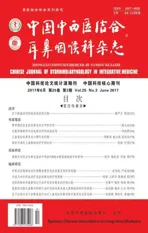儿童变应性鼻炎与心理行为问题*
2017-01-11冯博孩施云斌陈波蓓
冯博孩施云斌陈波蓓
儿童变应性鼻炎与心理行为问题*
冯博孩1施云斌1陈波蓓1
目前,变应性鼻炎(allergic rhinitis,AR)是影响儿童健康最常见的慢性疾病之一。鼻痒、喷嚏、鼻塞和流鼻涕是AR最典型的四大症状。绝大多数AR患者起病于儿童时期,后随着年龄增长患病率逐渐增高。国际儿童哮喘与变态反应研究系统评价了98个国家的哮喘、变应性鼻结膜炎及湿疹的发病情况后,发现6~7岁儿童的总患病率为8.5%,而13~14岁则为14.6%[1]。Westman等[2]在对2024名儿童的前瞻性研究中发现,AR患病率从4岁时的5%上升到8岁时的14%。Skoner[3]报道大于80%的AR患者在20岁之前出现症状。
AR的一些并发症,严重影响着患儿及其家庭的生活与工作[4,5],甚至超过了AR本身的症状。传统意义上的儿童AR并发症包括:分泌性中耳炎、慢性鼻窦炎、变应性哮喘及睡眠呼吸暂停等。一些研究也指出[6],一大部分AR的患儿同时会伴有睡眠障碍、学校表现不佳、生活质量下降及注意缺陷多动障碍等一系列相关的心理行为问题。2007年的一项前瞻性横断面调查显示[7]:74%的AR患者有工作或学习影响,大约50%出现睡眠障碍,而61%感觉易疲劳,38%表现易怒。本文对儿童AR的相关心理行为问题作一介绍,以期提高人们的重视,为当今儿童AR的诊治以及未来临床研究提供新方向。
1 夜间睡眠障碍
夜间睡眠障碍是AR患儿的常见困扰,在一项全科医生进行的调查中发现有34%的AR患儿及家庭生活受此影响[8]。在美国,Meltzer等[9]进行的一项针对过敏患儿的调查中,其中40%的AR患儿认为其症状影响了睡眠,32%入睡困难,26%伴夜间觉醒。Juniper等[10]在为青少年制定鼻结膜炎生活质量问卷时,调查了一组12~17岁的AR患儿,结果发现患儿中78%夜间睡眠不良,75%入睡困难,64%伴夜间觉醒。Blaiss[11]在一个针对AR患者的大规模调查发现,68%的常年性AR以及48%的季节性AR均存在不同程度的睡眠障碍。
一些研究分析了由AR症状引起睡眠障碍的可能原因。早期的一些研究[12-14]指出AR的鼻塞症状是睡眠障碍与白天易疲劳的主要原因。在一些量表[10,15]中夜间睡眠情况被用于评价AR患者的生活质量,并将鼻塞和睡眠障碍联系在一起。Camhi等[16]认为AR的其他症状,如喷嚏、眼痒、流鼻涕及鼻痒,也可导致患儿睡眠障碍。Chirakalwasan等[17]在2014年的一篇文献综述中提到AR可能通过影响组胺,半胱氨酰白三烯、IL-1β和IL-4等炎性因子水平,从而加重阻塞性睡眠呼吸暂停的发生。
由于鼻塞导致的夜间睡眠情况不佳,白天亦可出现一些不良症状。Léger等[18]的研究表明,由于AR患者入睡困难,导致其无法保证满意的睡眠时间及质量,使其醒来后仍然感到躯体疲劳。Santos等[14]发现AR患儿出现睡眠障碍多是由鼻黏膜充血而导致鼻塞症状而引起的,AR患儿在睡眠期间可能会出现微觉醒及不规则呼吸,这些因素可导致白天的躯体疲劳。Young等[19]的研究发现频繁出现夜间AR症状(每月>5d)患者更容易出现白天的过度嗜睡症状。北欧一个大型调查[20]结果表明,哮喘患者中伴发AR者更易导致入睡困难和白天嗜睡等情况。一些关于哮喘的研究中也也得出了相似的结论[21,22]。
目前使用客观指标来评估变应性疾病患儿睡眠情况的临床试验相对匮乏。Lavie等[23]在一项早期研究中,通过使用睡眠监测评估AR患者的睡眠状态,结果发现这些患者普遍存在睡眠障碍的问题。Rimmer等[24]的研究通过使用动态记录仪(一个评估睡眠质量腕带)来评价夜间睡眠情况,结果发现常年性AR患者的睡眠障碍程度更重。另外,Stuck等[25]做了一项对照临床研究,通过使用睡眠问卷调查及多导睡眠监测评估AR儿童及对照者的睡眠情况,结果发现患儿睡眠障碍症状更严重,更普遍伴发有白天嗜睡及生活质量不佳等情况。
2 在校表现不佳
Arrighi等[26]在一项早期研究中指出,AR的典型症状以及由其引起的如注意力不集中、焦虑及疲劳等伴随症状可能导致了患儿在学校的糟糕表现。1994年,在美国有824 000名患儿由于AR而缺课的经历[27]。Meltzer[28]通过调查指出,美国AR患儿的总缺课天数达到了200万日。Blaiss[29]认为AR患儿常常比一般儿童更频繁地缺课,也导致了患儿在成绩上的落后,种种这些情况导致了患儿心情的沮丧,不能很好地参与到团队活动中,从而导致了患儿在学校表现的不佳。一项英国研究调查了15~16岁的儿童在校考试成绩,发现季节性AR患者普遍较差,尤其是在使用第一代抗组胺药后这种情况更为严重[30]。2007年,Sundberg等[31]发表了一项囊括了9 538名青少年学生的调查研究,得出了相似的结果。
Bousquet等[32]认为AR可能引起一系列慢性上呼吸道疾病,而这些疾病及AR本身会对生活质量以及工作学习能力的严重影响。Jáuregui等[33]表示分泌性中耳炎是AR的常见并发症,其导致的传导性听力损失可能会加重学习功能障碍。Vuurman等[34]做了一项研究,在花粉季节对季节性AR患儿及对照者均使用计算机模拟系统进行教学,AR患儿在进行教学前接受不同种治疗,即第一代或二代抗组胺药或者安慰剂,两周后测试儿童上课知识掌握情况,结果发现安慰剂和抗组胺药组学习效率均明显低于正常对照组。Marshall等[35]的研究发现,在花粉季节,季节性AR患者的认知处理过程迟缓,并表现在工作学习效率低下。
3 注意缺陷多动障碍
AR患儿中普遍存在的白天注意力不集中、精神差、易激惹及多动症状,这恰恰与注意缺陷多动障碍(attention deficit hyperactivity disorder,ADHD)的典型症状重叠。而AR患儿中伴发ADHD症状的病理学机制尚未完全阐明。
Brawley等[36]评估了5~18岁ADHD患儿的过敏情况,对每一个患儿进行详细的询问病史、查体以及皮肤点刺试验,结果发现75%的ADHD患儿有两项或两项以上的AR典型症状,全部患儿具有AR的家族史,69%的患儿在皮肤点刺试验表现出一种或者多种变应原阳性。这项研究表明,鼻塞、睡眠障碍以及AR其他症状可能导致ADHD类似症状的发生。Yang等[37]使用AR症状评分、ADHD症状量表和计算机化连续性能测试,评估AR组、对照组以及ADHD组的差异,结果发现AR组在ADHD症状量表评分上比对照组更高。Chou等[38]通过分析台湾健康保险研究数据库后观察到AR患者中ADHD的患病率增加,而数据库内多为匿名信息,想要更进一步随访及研究的可能性小。因此,其间的关系仍然需要通过客观、科学的检测来研究AR儿童的ADHD情况。
Schans等[39]在近期发表的一项系统评价中指出,变应性疾病与ADHD存在很强的联系,变应性疾病个体患ADHD的风险比对照组高30%~50%。Kerr等[40]认为AR和ADHD都是高度遗传性的疾病,然而目前还没有发现同时涉及两者的致病基因,两者间关联性的病理学机制仍然知之甚少,不管是在正常人还是AR患者,免疫系统和神经系统之间的联系都是微妙和复杂的。Kronfol等[41]提出除了免疫细胞之间的相互作用外,一些细胞因子也可通过脑内的信号传导,引起产生神经内分泌、神经免疫及行为方面的异常。有些细胞因子可以同时作为神经和免疫调节剂,通过信号传导转移身体及心理的压力,这也可能是其病理生理学机制之一。Brawley等[36]认为对于两者间关联可能的解释是,ADHD是AR的一种行为并发症,AR症状以及躯体并发症等可能影响夜间睡眠状态,从而引起白天疲劳、注意力不集中和易冲动等症状。而对于夜间睡眠状态不佳对ADHD的影响一些学者[42-44]也提出了自己的观点。
当然,目前此领域的研究尚处于起步阶段,我们的团队在2017年发表了第一篇针对中国大陆儿童AR与ADHD关联性的研究论文[45],认为当对AR患儿进行管理时应注意合并存在易冲动和注意力不集中的可能性,这对于评估儿童青少年AR的ADHD症状是十分必要的。然而这还远远不够,国内该领域的研究依旧匮乏,需要更多的大样本、高质量及多中心研究来进一步证实这两者间的关系,其病理生理学机制也需要更多的基础研究进行深入探讨。
4 小结
AR严重影响着人们的日常生活,并造成了数十亿美元的直接或间接经济损失。但是由于种种主观客观的原因,仍然有一部分AR患者没有得到明确的诊断以及规范化的治疗。随着生活水平的提高,AR患儿的心理行为问题越来越受到重视,本文主要总结了该领域的相关研究进展。AR患儿可以导致夜间睡眠障碍、在校表现不佳及ADHD等多种伴发情况,其对患儿生活的影响甚至超过了AR症状的本身。所以,对于临床医生来说,AR患儿不仅应该关注其鼻眼症状及并发症的情况,相关的心理及行为问题也同样需要得到重视。此外,在表现出ADHD症状的儿童中,不仅应该考虑ADHD本身,还应考虑变应性疾病。
1 Fernandez F,Porras G,Mormède P,et al.The International Study of Asthma and Allergies in Childhood (ISAAC)Phase Three:a global synthesis.Allergol Immunopathol(Madr),2013,41(2):73-85.
2 Westman M,Stjrne P,Asarnoj A,et al.Natural course and comorbidities of allergic and nonallergic rhinitis in children.J Allergy Clin Immunol,2012,129(2):403-408.
3 Skoner DP.Allergic rhinitis:definition,epidemiology, pathophysiology,detection,and diagnosis.J Allergy Clin Immunol,2001,108(1 Suppl):2-8.
4 Meltzer EO.Allergic rhinitis:managing the pediatric spectrum.Allergy Asthma Proc,2006,27(1):2-8.
5 Stokes J,Fenstad E,Casale TB.Managing impairment in patients with allergic rhinitis.Allergy Asthma Proc,2006, 27(27):12-16.
6 Meltzer EO.Allergic Rhinitis:Burden of Illness,Quality of Life,Comorbidities,and Control.Immunol Allergy Clin North Am,2016,36(2):235-248.
7 Schatz M.A survey of the burden of allergic rhinitis in the USA.Allergy,2007,62 Suppl 85:9-16.
8 Scadding GK,Richards DH,Price MJ.Patient and physician perspectives on the impact and management of perennial and seasonal allergic rhinitis.Clin Otolaryngol, 2000,25(6):551-557.
9 Meltzer EO,Blaiss MS,Derebery MJ,et al.Burden of allergic rhinitis:Results from the Pediatric Allergies in America survey.J Allergy Clin Immunol,2009,124(3): 43-70.
10 Juniper EF,Guyatt GH,Dolovich J.Assessment of quality of life in adolescents with allergic rhinoconjunctivitis:development and testing of a questionnaire for clinical trials.J Allergy Clin Immunol,1994,93(2):413-423.
11 Blaiss MS.Important aspects in management of allergic rhinitis:compliance,cost,and quality of life.Allergy Asthma Proc,2003,24(4):231-238.
12 Mcnicholas WT,Tarlo S,Cole P,et al.Obstructive apneas during sleep in patients with seasonal allergic rhinitis.Amn Rev Respir Dis,1982,126(4):625-628.
13 Staevska MT,Mandajieva MA,Dimitrov VD.Rhinitis and sleep apnea.Curr Allergy Asthma Rep,2004.4(3):193-199.
14 Santos CB,Pratt EL,Hanks C,et al.Allergic rhinitis and its effect on sleep,fatigue,and daytime somnolence.Ann Allergy Asthma Immunol,2006,97(5):579-586.
15 Juniper EF,Rohrbaugh T,Meltzer EO.A questionnaire to measure quality of life in adults with nocturnal allergic rhinoconjunctivitis.J Allergy Clin Immunol,2003.111 (111):484-490.
16 Camhi SL,Morgan WJ,Pernisco N,et al.Factors affecting sleep disturbances in children and adolescents.Sleep Med,2000.1(2):117-123.
17 Chirakalwasan N,Ruxrungtham K.The linkage of allergic rhinitis and obstructive sleep apnea.Asian Pac J Allergy Immunol,2014.32(4):276-286.
18 Léger D,Annesimaesano I,Carat F,et al.Allergic Rhinitis and Its Consequences on Quality of Sleep:An Unexplored Area.Arch Intern Med,2006,166(16):1744-1748.
19 Young T,Finn L,Kim H.Nasal obstruction as a risk factor for sleep-disordered breathing.The University of Wisconsin Sleep and Respiratory Research Group.J Allergy Clin Immunol,1997,99(2):757-762.
20 Janson C,De BW,Gislason T,et al.Increased prevalence of sleep disturbances and daytime sleepiness in subjects with bronchial asthma:a population study of young adults in three European countries.Eur Respir J,1996,9(10): 2132-2138.
21 Bender BG,Ballard R,Canono B,et al.Disease severity, scratching,and sleep quality in patients with atopic dermatitis.J Am Acad Dermatol,2008,58(3):415-420.
22 Colás C,Galera H,A ibarro B,et al.Disease severity impairs sleep quality in allergic rhinitis (The SOMNIAAR study).Clin Exp Allergy,2012,42(7):1080-1087.
23 Lavie P,Gertner R,Zomer J,et al.Breathing disorders in sleep associated with"microarousals'in patients with allergic rhinitis.Acta OtoLaryngol,1981,92(1-6):529-533.
24 Rimmer J,Downie S,Bartlett DJ,et al.Sleep disturbance in persistent allergic rhinitis measured using actigraphy.Ann Allergy Asthma Immunol,2009,103(3):190-194.
25 Stuck BA,Czajkowski JHagner AE,Klimek L,et al.Changes in daytime sleepiness,quality of life,and objective sleep patterns in seasonal allergic rhinitis:a controlled clinical trial.J Allergy Clin Immunol,2004,113 (4):663-668.
26 Arrighi HM,Cook CK,Redding GJ.The prevalence and impact of allergic rhinitis among teenagers.J Allergy Clin Immunol,1996,97(1):430-430.
27 Juniper EF,Guyatt GH,Dolovich J.Assessment of quality of life in adolescents with allergic rhinoconjunctivitis:development and testing of a questionnaire for clinical trials.J Allergy Clin Immunol,1994,93(2):413-423.
28 Meltzer EO.Quality of life in adults and children with allergic rhinitis.J Allergy Clin Immunol,2001,108(1 Suppl):S45.
29 Blaiss MS.Allergic Rhinitis in Schoolchildren Consensus Group.Allergic rhinitis and impairmentissues in schoolchildren:a consensus report.Curr Med Res Opin, 2004,20(12):1937-1952.
30 Walker S,Khan-Wasti S,Fletcher M,et al.Seasonal allergic rhinitis is associated with a detrimental effect on examination performance in United Kingdom teenagers: case-control study.J Allergy Clin Immunol,2007,120(2): 381-387.
31 Sundberg R,Torén K,Hglund D,et al.Nasal symptoms are associated with school performance in adolescents.J Adolesc Health,2007,40(6):581-583.
32 Bousquet J,Bachert C,Canonica GW,et al.Unmet needs in severe chronic upper airway disease(SCUAD).J Allergy Clin Immunol,2009,124(3):428-433.
33 Jáuregui I,Mullol J,Dávila I,et al.Allergic rhinitis and school performance.J Investig Allergol Clin Immunol, 2009,19 Suppl 1:32-39.
34 Vuurman EF,van Veggel LM,Uiterwijk MM,et al.Seasonal allergic rhinitis and antihistamine effects on children's learning.Ann Allergy,1993,71(2):121-126.
35 Marshall PS,O'Hara C,Steinberg P.Effects of seasonal allergic rhinitis on selected cognitive abilities.Ann Allergy Asthma Immunol,2000,84(4):403-410.
36 Brawley A,Silverman B,Kearney S,et al.Allergic rhinitis in children with attention-deficit/hyperactivity disorder.Ann Allergy Asthma Immunol,2004,92(6):663-667.
37 Yang MT,Lee WT,Liang JS,et al.Hyperactivity and impulsivity in children with untreated allergic rhinitis:corroborated by rating scale and continuous performance test.Pediatr Neonatol,2014,55(3):168-174.
38 Chou PH,Lin CC,Lin CH,et al.Prevalence of allergic rhinitis in patients with attention-deficit/hyperactivity disorder:a population-based study.Eur Child Adolesc Psychiatry,2013,22(5):301-307.
39 Schans JV,Iek R,De Vries TW,et al.Association of atopic diseases and attention-deficit/hyperactivity disorder:A systematic review and meta-analyses.Neurosci Biobehav Rev,2017,74(Pt A):139-148.
40 Kerr D,Krishnan C,Pucak ML,et al.The immune system and neuropsychiatric diseases.Int Rev Psychiatry,2005, 17(6):443-449.
41 Kronfol Z,Remick DG.Cytokines and the brain:implications for clinical psychiatry.Am J Psychiatry,2000,157 (5):683-694.
42 Craig TJ,Teets S,Lehman EB,et al.Nasal congestion secondary to allergic rhinitis as a cause of sleep disturbance and daytime fatigue and the response to topical nasal corticosteroids.J Allergy Clin Immunol,1998,101 (5):633-637.
43 Konrad K,Eickhoff SB.Is the ADHD brain wired differently A review on structural and functional connectivity in attention deficit hyperactivity disorder.Hum Brain Mapp, 2010,31(6):904-916.
44 Bush G,Valera EM,Seidman LJ.Functional neuroimaging of attention-deficit/hyperactivity disorder:a review and suggested future directions.Biol Psychiatry,2005,57(11): 1273-1284.
45 Feng B,Jin H,Xiang H,et al.Association of pediatric allergic rhinitis with the ratings of attention-deficit/hyperactivity disorder.Am J Rhinol Allergy,2017,31(3):161-167.
(收稿:2017-05-31)
10.16542/j.cnki.issn.1007-4856.2017.03.004
国家临床重点专科(儿科呼吸)开放项目(No.523302)
1 温州医科大学附属第二医院耳鼻咽喉科(浙江,325027)
陈波蓓,主任医师.Email:wzbobei@hotmail.com
